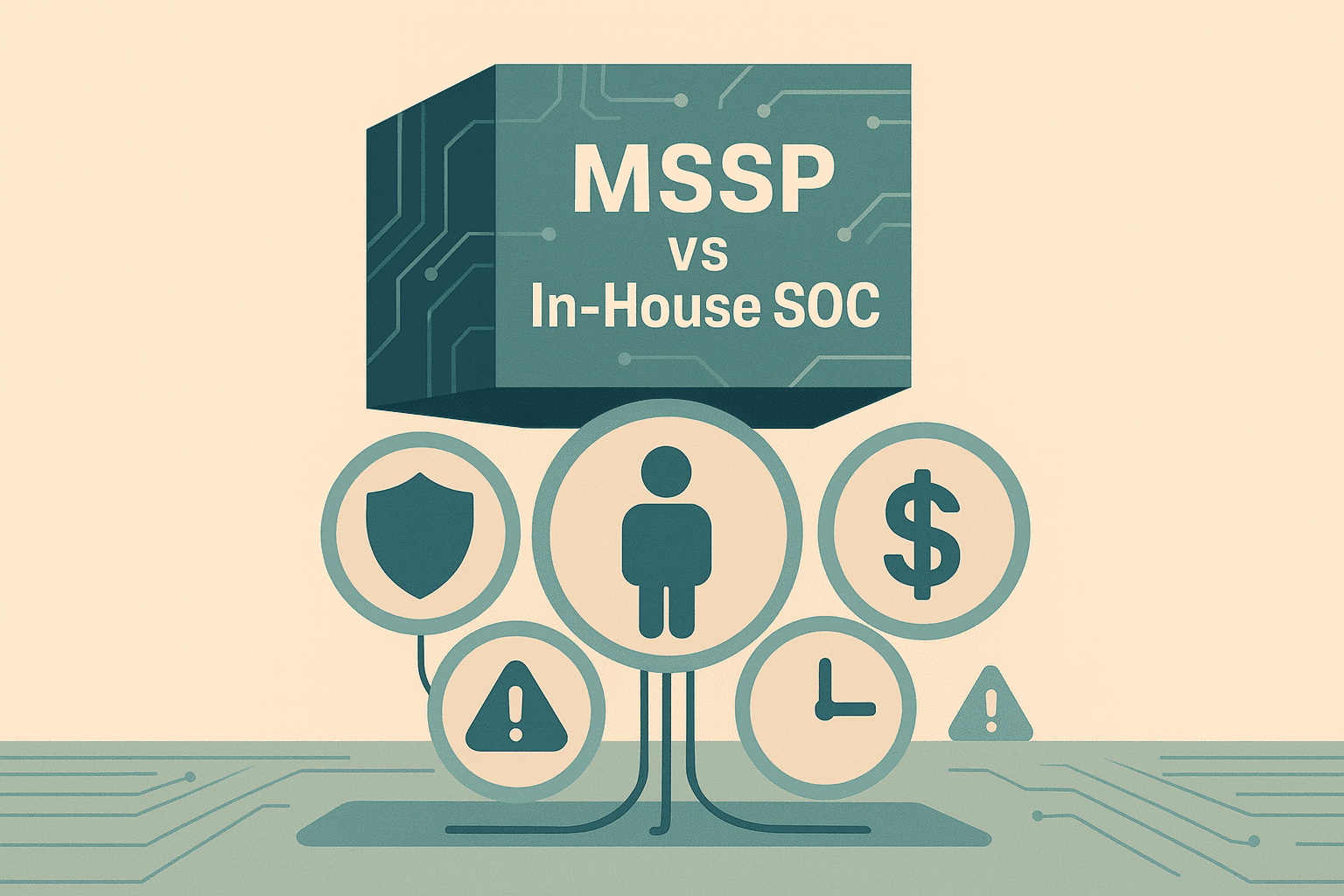Here’s the deal: protecting your company from cyber threats isn’t optional anymore. But you’re stuck deciding whether to hire a managed security service provider (MSSP) or build your own security operations center.
Both paths can work. The question is which one makes sense for your situation.
If you’re trying to figure out whether outsourced monitoring beats an internal security team, you’re not alone. This decision affects everything from your monthly budget to how fast you can respond when something goes wrong. And let’s be honest—something will eventually go wrong.
This guide breaks down what actually matters when choosing between these two approaches.
Quick Overview: What You’re Really Comparing
Here’s what you need to know upfront:
Managed Security Services (MSSP/SOCaaS)
- Monthly subscription model with predictable costs
- Round-the-clock monitoring starts immediately
- Access to experienced security analysts without hiring
- Broader threat intelligence from multiple clients
- Less direct control over day-to-day operations
Internal Security Operations Center
- Significant upfront investment in people and technology
- Complete authority over policies and procedures
- Builds institutional knowledge within your company
- Requires ongoing recruitment and training
- Higher total cost but greater customization
| Factor | Managed Service Provider | Internal Security Team |
| Initial Investment | Low—subscription starts right away | High—recruiting, tools, infrastructure |
| Monthly Costs | Predictable flat fee | Variable—salaries, benefits, licenses |
| Monitoring Coverage | 24/7 included as standard | Requires multiple shift teams |
| Time to Full Protection | Days to weeks | Months to a year |
| Threat Intelligence | Aggregated from all customer environments | Limited to your network activity |
| Customization Level | Medium—within provider’s framework | High—you build exactly what you need |
| Staffing Requirements | None—fully handled by provider | 5-10+ specialists for comprehensive coverage |
| Long-Term Dependency | Vendor relationship required | Self-sufficient but expensive |
Breaking Down Managed Security Services
What You Actually Get
When you sign up with a managed security provider, you’re essentially renting an entire security operation. They handle the monitoring, provide the technology platforms, and staff the analyst positions.
The good news is you don’t have to assemble anything yourself. Your provider brings security information and event management (SIEM) tools, endpoint detection capabilities, threat intelligence feeds, and ticketing systems already configured and ready to work.
Most importantly, you get experienced professionals who’ve seen attacks across dozens or hundreds of other companies. That experience translates to faster threat recognition and more effective responses.
The Trade-Offs
You’ll give up some direct control. Instead of making split-second decisions yourself, you approve policies and let the provider execute them. For some organizations, that’s uncomfortable. For others, it’s a relief.
According to insights from msspsecurity.com, the distinction between different managed security models matters less than understanding what level of involvement you want to maintain.
When This Approach Makes Sense
Choose managed services when you need:
- Immediate 24/7 protection without a lengthy hiring process
- Predictable monthly expenses instead of variable staffing costs
- Access to enterprise-grade security tools without buying them outright
- Threat intelligence from a broader range of sources
- Faster time-to-value—usually weeks instead of months
Building Your Own Security Operations Center
What Internal Teams Deliver
An in-house SOC gives you complete authority. You hire the analysts, choose the tools, write the policies, and decide how everything operates.
Your team learns your environment intimately. They understand your business processes, know your applications, and can customize responses to fit your exact needs. That deep knowledge can be incredibly valuable.
The Real Costs
Security analysts with solid experience command salaries above $124,000 annually, and that’s before benefits, training, and retention bonuses. For genuine 24/7 coverage, you need at least three analysts per role to cover all shifts, weekends, and vacation time.
Then add the technology costs. You’re buying your own SIEM platform, endpoint detection tools, threat intelligence subscriptions, and ticketing systems. Each requires implementation time, configuration, and ongoing maintenance.
When Internal Security Works Best
Build your own team when you:
- Have budget for substantial upfront and ongoing investment
- Need highly customized security processes for unique business requirements
- Want to develop institutional security knowledge and expertise
- Already have strong technical leadership to manage the program
- Can commit to continuous recruitment and training
What Affects Your Decision Most
Coverage Requirements
Do you need protection only during business hours, or around the clock? Many companies underestimate how much 24/7 coverage actually costs with internal staff.
Three eight-hour shifts, seven days a week, across multiple analyst roles adds up quickly. Managed providers spread those costs across their entire client base.
Current Security Maturity
If you already have security tools and some staff, building on that foundation might make sense. Starting from scratch makes managed services more attractive.
Compliance Obligations
Some regulations require specific controls over who accesses your systems and data. Review your compliance requirements carefully—they might limit your options.
Speed Matters
A helpful guide on MSSP vs. MDR vs. in-house SOC explains how different security models compare when time-to-protection matters.
The average data breach costs $4.4 million in 2025. Every month you operate without adequate security increases that risk. Managed services get you protected in weeks. Internal teams take months to build out properly.
Hidden Factors Most Companies Miss
The Hiring Challenge
Finding qualified security analysts is brutal. They’re in high demand, expensive, and hard to retain. Expect lengthy searches and prepare for regular turnover.
Even when you find good people, they need time to learn your environment. That learning curve extends your time-to-value significantly.
Pricing Variability with Managed Services
Many providers use per-user or consumption-based pricing models. Your bill fluctuates as your company grows or as security events increase.
Look for providers offering fixed monthly rates so your budget stays predictable. Variable pricing defeats one of the main advantages of managed services.
Maintenance and Updates
Security tools require constant updates. Threat signatures, detection rules, platform patches—someone has to manage all of it.
With managed services, that’s included. With internal teams, it’s additional work competing with active monitoring and incident response.
Knowledge Transfer Risks
If you ever want to switch from a managed provider to internal security, will you have the data and documentation you need? Clarify data retention policies and get regular reports on your security posture.
Similarly, internal team members eventually leave. How do you preserve their knowledge and avoid starting over?
How to Choose the Right Path for Your Organization
Match Your Resources to Reality
Start with an honest assessment. What’s your actual budget for security? Not the aspirational number, but what you can truly allocate consistently.
Can you afford $500,000 to $1,000,000 annually for a basic internal security operation? If not, managed services make more sense.
Consider Your Timeline
How quickly do you need protection? If you’re facing immediate compliance deadlines or recent security scares, you can’t wait six months to build a team.
Evaluate Your Risk Tolerance
Some industries face constant, sophisticated attacks. Others deal with more opportunistic threats. Higher risk environments might justify the investment in specialized internal expertise.
Think About Your Growth Plans
If you’re expanding rapidly, managed services scale easily. Adding coverage for new users, offices, or systems is usually straightforward.
Internal teams struggle more with sudden scaling needs. Hiring and training takes time you might not have during rapid growth.
Assessment Checklist
- What’s your realistic annual security budget?
- Do you have technical leadership capable of managing a security program?
- How quickly do you need comprehensive protection?
- What are your compliance and regulatory requirements?
- Can you commit to ongoing recruitment and training?
- Do you need highly customized security processes?
- How comfortable are you depending on an external provider?
Practical Ways to Maximize Your Security Investment
If You Choose Managed Services
Lock Down Your Contract Get clear service level agreements for every incident type. Understand exactly what’s included in your subscription and what costs extra. Ask about their cybersecurity service guarantee.
Maintain Some Internal Capability Even with a managed provider, keep someone internal who understands security. They’ll manage the relationship, translate business needs, and maintain institutional knowledge.
Request Regular Reviews Meet with your provider quarterly to review your security posture, discuss emerging threats, and adjust your coverage as needed.
If You Build Internal Capability
Start with Clear Playbooks Document your incident response procedures before you need them. Test them regularly with tabletop exercises.
Invest in Threat Intelligence Sharing Join information sharing groups in your industry. You’ll get early warnings about relevant threats without the cost of a large provider’s intelligence operation.
Use the MITRE ATT&CK Framework This free framework helps you understand attacker techniques and build appropriate defenses. It levels the playing field significantly.
Plan for Retention Budget for competitive salaries, ongoing training, and career development. Losing a trained analyst costs you months of institutional knowledge.
Consider the Hybrid Approach
You don’t have to choose just one model. Many companies use a co-managed approach where internal staff handle strategy and policy while a managed provider delivers 24/7 monitoring and initial response.
How Hybrid Models Work:
- Your team sets security policies and manages compliance requirements
- The managed provider monitors your environment continuously
- Both teams share access to the same security platforms and data
- You retain approval authority for major actions
- The provider handles routine responses and escalates complex incidents
Why This Often Works Best:
- Fills expertise gaps without completely outsourcing
- Provides 24/7 coverage at a fraction of the cost of full internal staffing
- Maintains internal security knowledge while accessing external experience
- Scales more easily than purely internal operations
Success Factors for Hybrid Models:
- Crystal-clear role definitions—who does what
- Shared visibility into all security platforms and data
- Regular joint meetings to maintain alignment
- Documented escalation procedures
- Joint incident response drills
Key Takeaways
- Managed security services cost significantly less than building internal teams and get you protected in weeks instead of months
- Internal SOCs provide maximum control and build institutional expertise but require substantial ongoing investment in staff and technology
- True 24/7 coverage with internal staff requires at least three people per role across all shifts, dramatically increasing costs
- Managed providers see threats across many clients, giving them broader threat intelligence than most single companies can develop alone
- The average data breach costs $4.4 million, making speed-to-protection a critical factor in your ROI calculation
- Hiring and retaining qualified security analysts remains challenging for all organizations, regardless of budget
- Hybrid approaches combining internal strategy with managed monitoring often deliver the best balance of control and cost-effectiveness
- Predictable monthly costs with managed services help budget planning compared to variable staffing and tool expenses
- Review your choice regularly—what works today might not fit your needs in 18-24 months as your company evolves
Frequently Asked Questions
How much does it really cost to run an internal security operations center?
For basic 24/7 coverage, expect $800,000 to $1,200,000 annually minimum. That includes salaries for 6-9 analysts (covering all shifts), a security manager, technology platforms (SIEM, EDR, threat intelligence), and ongoing training. Larger or more complex environments easily exceed $2,000,000 annually. Managed services typically run $50,000 to $200,000 annually depending on your organization size.
Can a managed provider respond as quickly as an internal team during an incident?
Often yes, sometimes faster. Managed providers have 24/7 staffing, established playbooks, and experience handling similar incidents across many clients. Internal teams can match this speed only if you maintain full-time overnight coverage and practice your procedures regularly. The bottom line: response speed depends more on preparation and coverage than whether your team is internal or external.
What happens to my security data if I stop using a managed provider?
This depends entirely on your contract. Before signing, clarify data retention policies, export formats, and access duration after contract termination. Get regular security reports throughout your relationship so you’re never starting from scratch. Most reputable providers offer transition periods and data exports, but confirm this upfront.
Do I lose control over security decisions with a managed service?
Not if you set things up correctly. You still approve policies, set risk tolerance levels, and define what requires your authorization. The provider executes your policies and handles routine operations. Think of it like hiring a contractor—you’re still the homeowner making decisions about your house. Clear service level agreements prevent surprises.
How do I know if my current security setup is actually working?
Track these metrics: mean time to detect threats (MTTD), mean time to respond (MTTR), false positive rates, and coverage gaps. If you can’t measure these consistently, that’s a problem. Both managed providers and internal teams should report on these regularly. Quarterly tabletop exercises also reveal whether your procedures actually work under pressure.
Is a hybrid approach more expensive than choosing one model?
Not necessarily. Hybrid models cost more than pure managed services but far less than full internal teams. You’re essentially paying for managed monitoring and response while maintaining smaller internal staff for strategy and oversight. Many organizations find this delivers the best value—professional 24/7 coverage without the full cost of internal overnight shifts.
What’s the biggest mistake companies make when choosing between these options?
Underestimating the true cost and complexity of internal security operations. Companies see the managed service price tag and think “we could do this cheaper ourselves.” Then they discover what 24/7 staffing, technology platforms, training, and retention actually cost. The second biggest mistake is choosing based solely on cost without considering speed-to-protection and the potential cost of breaches during the buildout period.



































